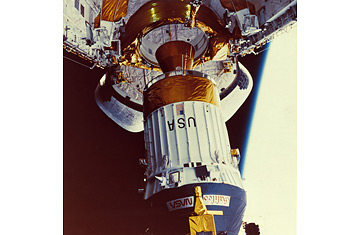
The Galileo probe after its detachment from the cradlelike device aboard the earth-orbiting space shuttle Atlantis
Oct. 18, 1989 — Actually, "launched" is not the appropriate word for the beginning of the Galileo mission. It didn't make its own way into space at all but rather rode along in the cargo bay of the shuttle Atlantis, which released it in the earth's orbit. Instead of carrying its own powerful engine that would then blast it on a beeline to Jupiter, Galileo was equipped with a smaller engine that required it to spiral its way out through the solar system, taking a full six years to get where it was going. This was a concession to nervous mission planners, who no longer trusted a shuttle to carry more than a little explosive fuel in its payload bay. Ingenious engineers overcame all manner of problems during Galileo's six-year journey, including an umbrella-like high-gain antenna that never opened properly and a computer with a primitive reel-to-reel data-storage system that slipped its spools. The limping probe not only managed to arrive; it thrived, surveying Jupiter and its moons for eight years before engineers finally crashed it into Jupiter, ensuring that it could never collide with any of the planet's inner moons and contaminate bodies that many believe could harbor life.